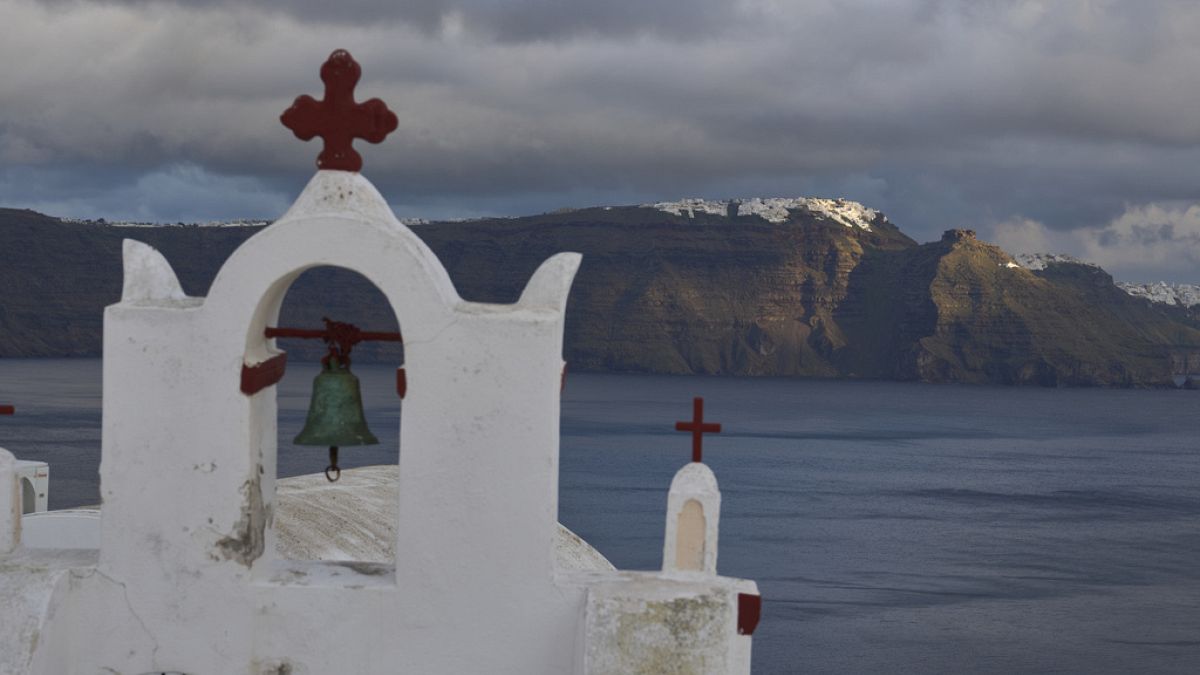Europe
Santorini targeted by fake volcano eruption videos

Santorini’s Crisis Amidst False Narratives: A Fight Against Misinformation
Santorini, the picturesque Greek island renowned for its iconic white buildings, blue-domed churches, and stunning sunsets, has recently become the center of a misleading viral phenomenon. While the island is grappling with a real state of emergency caused by numerous earth tremors, false and sensationalized videos have been circulating online. These videos, many of which are AI-generated or miscaptioned, falsely depict Santorini engulfed in lava flows, volcanic eruptions, and chaotic scenes of people fleeing in terror. The spread of these videos has caused widespread confusion, fear, and concern among locals and tourists alike, further complicating the island’s ongoing challenges.
The False Videos: How Misinformation Took Hold
The majority of these misleading videos have been shared on platforms like TikTok and X (formerly Twitter), where they have garnered thousands of views, shares, and likes. One of the most widely circulated videos shows lava streaming down cliffsides into the sea, with volcanoes erupting in the background. Another video depicts panic-stricken crowds running through Santorini’s narrow streets as flames engulf the iconic blue-roofed buildings. A third video purports to show smoke billowing from the island, with a caption claiming a recent volcanic eruption. However, upon closer inspection, these videos reveal telltale signs of manipulation. The artificial appearance of the sea, distorted human figures, and inconsistencies in the scenery all point to the fact that some of these clips are AI-generated creations rather than real events.
In one video, the sea appears unnaturally exaggerated, with lava interacting with water in ways that defy natural physics. In another, the individuals fleeing in panic are blurred, distorted, and lack definable features, a common trait of AI-generated imagery. A reverse image search of the third video, which supposedly shows Santorini engulfed in smoke, revealed that the footage actually depicts Whakaari (White Island) in New Zealand, an active volcano that last erupted in December 2019. These false depictions have not only caused panic but have also brought international attention to Santorini for all the wrong reasons.
The Real Crisis: Earth Tremors and a State of Emergency
While the viral videos paint a dramatic and fictional picture of Santorini being consumed by volcanic activity, the island is facing a very real and pressing crisis. Since late January, Santorini has experienced over 800 earth tremors, many with a magnitude of 3 or higher, prompting a state of emergency that will remain in place until early March. The strongest tremor, measuring 5.2 on the Richter scale, occurred on February 5 and was felt as far away as Athens, Crete, and parts of Turkey. Although the tremors have caused minimal damage so far, their frequency and intensity have raised significant concerns among residents and experts.
The seismic activity has led to the evacuation of thousands of people from Santorini and neighboring islands, including Amorgos, Anafi, and Ios. Many have temporarily relocated to safer areas, leaving behind their homes and livelihoods. The Greek government has responded by allocating €3 million to construct an emergency evacuation route in the southern part of Santorini, a measure aimed at ensuring the safety of both residents and tourists in the event of a more catastrophic event. Despite these efforts, the exact cause of the tremors remains unclear, and experts are unsure whether this swarm of earthquakes could signal a more powerful quake in the future.
Conspiracies and Speculation: Seeking Scapegoats
Amid the chaos and uncertainty, conspiracy theories have begun to circulate, with some suggesting that Turkey is behind the misleading videos in an effort to tarnish Santorini’s reputation and harm its tourism industry. However, there is no concrete evidence to support this claim, and the Turkish Ministry of Culture and Tourism has not responded to requests for comment on the matter. While the theories are unfounded, they highlight the broader issue of misinformation and the ease with which it can spread during times of crisis. The lack of transparency and accountability in the creation and dissemination of these videos has only exacerbated the situation, leaving many to wonder about the true motives behind such coordinated efforts to mislead the public.
The Human Impact: Fear, Displacement, and Uncertainty
Beyond the viral videos and speculation, the real human cost of this crisis cannot be overlooked. The ongoing earth tremors have instilled fear and uncertainty in the hearts of Santorini’s residents and visitors. Thousands have fled the island, leaving behind their homes, businesses, and sense of normalcy. The emotional toll of living through a state of emergency should not be underestimated, as people struggle to cope with the constant threat of a potential disaster. The evacuation efforts, while necessary, have also disrupted lives and livelihoods, raising questions about the long-term impact on the island’s economy and community.
Conclusion: Lessons Learned and Moving Forward
The situation in Santorini serves as a stark reminder of the destructive power of misinformation and the importance of critically evaluating the content we consume online. While the island continues to face real challenges in the form of earth tremors, the spread of false and sensationalized videos has only compounded the crisis. By promoting media literacy, encouraging fact-based reporting, and supporting fact-checking initiatives, we can work to mitigate the spread of misinformation in the future. For Santorini, the road ahead will require resilience, solidarity, and a commitment to addressing both the natural challenges and the human-made ones that have further complicated this delicate situation.


















